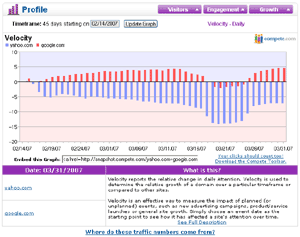 All web analytics track your activity somewhere along pipeline connecting your computer to a website’s server. Comscore tracks traffic trends on computers of 2 million users. Hitwise catches traffic at the ISP level and matches it up with demographic data they collected. Compete, Quantcast, and Alexa differ from these other web metrics companies by tracking traffic on the computers of users who installed their tool bars. Each of these services gauge critical marketing metrics such as unique visitors and page views.
All web analytics track your activity somewhere along pipeline connecting your computer to a website’s server. Comscore tracks traffic trends on computers of 2 million users. Hitwise catches traffic at the ISP level and matches it up with demographic data they collected. Compete, Quantcast, and Alexa differ from these other web metrics companies by tracking traffic on the computers of users who installed their tool bars. Each of these services gauge critical marketing metrics such as unique visitors and page views.
However, some people argue that the page view is no longer a proper measure of a website’s heft. New web page design principles such as Flash and AJAX are making constant page requests obsolete. One of the most extreme examples of this phenomenon is Justin.TV where you can log on and never refresh the page. This is great news for web users, but it’s sowing confusion among advertisers over how to peg a site’s true advertising appeal.
 Comscore, who’s currently looking to go public, has been evolving their metrics to keep up with the changes. They recently announced their “visit” metric after facing some heat by BusinessWeek over ranking MySpace above Yahoo’s in monthly page views last November. The visit metric was meant to gauge user engagement by counting the number of unique requests for a site at least a half hour from the last request. All those pesky MySpace page requests would be lumped into one visit, giving a fairer idea of how often each unique user was engaging with a website each month. It had the result they wanted, bumping Yahoo back on top.
Comscore, who’s currently looking to go public, has been evolving their metrics to keep up with the changes. They recently announced their “visit” metric after facing some heat by BusinessWeek over ranking MySpace above Yahoo’s in monthly page views last November. The visit metric was meant to gauge user engagement by counting the number of unique requests for a site at least a half hour from the last request. All those pesky MySpace page requests would be lumped into one visit, giving a fairer idea of how often each unique user was engaging with a website each month. It had the result they wanted, bumping Yahoo back on top.
Compete also has a visit metric. But today they also launched a new metric called “attention,” which argue see as a better measure of user engagement. Attention is the total amount of time U.S. users spend on a website as a percentage of total time spent on the Internet by all U.S. users. It’s analogous to Alexa’s reach metric, which tracks the number of visitors to a site as a percentage of total internet users. Compete’s attention metric is like airtime, whereas Alexa’s reach is more like audience size.
According to Compete, we spend about 1% of our internet time on YouTube. Compete also tracks the change in attention over time, called velocity, unique visitors per month, site visits, page views per visit, and average stay.